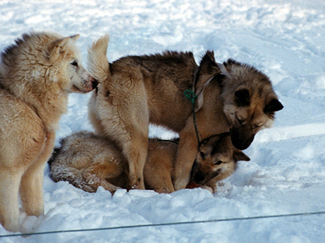In This Issue...
*
F.I.D.O.: Marit Holm
*
Nunavik Dog Slaughters, Part III
*
Greenland Dog / Inuit Dog, The Same Dog
*
Differences in Mushing: Greenland and Arctic Canada, Part I
*
Fan Mail
*
Behavior Notebook: The Human Role
*
Book Review: Frozen Horizons
*
Product Review: Wheel Dog Harness
*
Tip for the Trail: Pack a Pruning Saw
*
IMHO: The System
*
Annual Index for Volume 7
Navigating This
Site
Index of articles by subject
Index
of back issues by volume number
Search The
Fan Hitch
Articles
to download and print
Ordering
Ken MacRury's Thesis
Our
comprehensive list of resources
Talk
to The
Fan Hitch
The Fan
Hitch home page
ISDI
home page
Editor's/Publisher's Statement
Editor: Sue Hamilton
Webmaster: Mark Hamilton
The Fan Hitch welcomes your letters, stories, comments and suggestions. The editorial staff reserves the right to edit submissions used for publication.
Contents of The Fan Hitch are protected by international copyright laws. No photo, drawing or text may be reproduced in any form without written consent. Webmasters please note: written consent is necessary before linking this site to yours! Please forward requests to Sue Hamilton, 55 Town Line Rd., Harwinton, Connecticut 06791, USA or mail@thefanhitch.org.
This site is dedicated to the Inuit Dog as well as related Inuit culture and traditions. It is also home to The Fan Hitch, Journal of the Inuit Sled Dog.

Dogs in Greenland. Note the dominant dog
has a shortened
tail. This may not have
been the result of a
fight.
Photo:
Hamilton
The Human Role
by Mark Hamilton
The path Qiniliq has taken to his position as boss dog has been fascinating to observe. So has the ongoing development of an adult canine relationship between Qiniliq and Sunny. As a result of the sudden death of his boss, Puggiq, Qiniliq was thrust into "on the job training" for the position of boss dog while he was still young and before he had exhibited any aspirations for leadership.
When Qiniliq's interactions with Sunny indicated to us that he saw the need to mold the younger dog into something that fit into an adult canine society, we began teaching Sunny about his adult relationship with humans. This was a matter of (a) withdrawing his "puppy privileges" and then (b) establishing in his mind that he needed to pay attention and respond to all our commands. The first was accomplished with enforcing the "No" command while teaching Sunny to "Sit!" and "Wait!" and earn human attention. The second was primarily accomplished with brief, on-leash training sessions. Once Sunny learned to focus on his human handler, the on-leash training sessions were conducted in the same open area where the rest of his group was running around and playing off-leash.
One of the more interesting things observed during these training sessions was behavior by Qiniliq directed at Sunny. Early in Sunny's training, when more corrections were being given, we observed Qiniliq taking on a "harder", less tolerant position with Sunny as well. We also observed that this "hard", less tolerant attitude quickly came to characterize all interactions between Qiniliq and Sunny, not just during the training sessions. Later, as Sunny learned his new tasks, and required far fewer corrections, Qiniliq too found less offense in the junior dog's behavior. Again, this change characterized all interactions between Qiniliq and Sunny, not just during Sunny's training sessions.
Qiniliq had recognized that one his responsibilities as boss dog was that he was now required to back us up in our interactions with other dogs. That was good. In the Arctic the boss dog traditionally "has your back" around the other dogs. Even more important was that Qiniliq was taking his cues from our actions in determining what he should do. He acted autonomously, but in concert with our actions. Those two realizations by Qiniliq represented major growth on his part into his new social role: actively building the "partners" relationship a boss dog enjoys with his owners and handlers.
It is critical for Sue and me to continually acknowledge that we are part of the social environment within which Qiniliq and Sunny live. We have influence within that environment, and we must either use that influence wisely, or we will likely make a total mess of things. We underscore Qiniliq's position as boss dog in our relationship with him. Qiniliq enjoys privileges: first to be fed, first attention from us, easy access to our faces, more interactive play behavior which Sunny is either denied or receives only in strictly limited circumstances. This is to say, Qiniliq's special social position as leader of his pack and his relationship with us is reinforced by our display in front of the other dogs.
At the same time, we have to be aware that our new boss
dog is monitoring
our actions with the other dogs in his pack. Our
corrections to other dogs
have to be measured and proportional so as not to elicit
additional disproportionate
corrections from Qiniliq to the same dog. We have to make
corrections and
then return to either an emotionally neutral or a positive
demeanor, or
Qiniliq will take his cues from our negative attitude and
act accordingly.
In that respect, it's just one more reason to be happy
around our dogs,
and a very good reason at that. And why would being
unhappy around one's
dogs ever be a good idea?